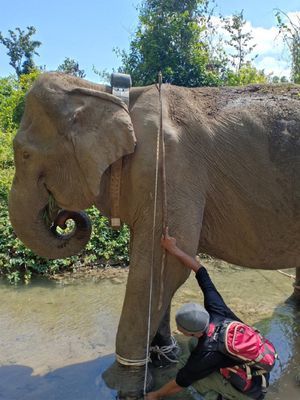This past year AES purchased a GPS collar for wild elephants in the Aceh region of Sumatra. At the end of November, a wild female was fitted with one of the collars. Below is the translated text of the Indonesian article (please click here to see the original).
“BANDA ACEH , KOMPAS.com - Aceh Natural Resources Conservation Center ( BKSDA ) team has just treated a mother elephant who inhabited the forest of Mount Biram, Aceh Besar. Previously, the elephant's mother was reported by people around the forest to have appeared for several weeks. The community also reported a wound at the base of the tail and the left chest which worsened on the parent elephant. After receiving the news, the Head of the Aceh BKSDA Sapto Adji Prabowo instructed the handling. On Wednesday (11/28/2018), the BKSDA team and Wildlife Ambulance from the PKSL (Center for Wildlife Studies) FKH Unsyiah immediately observed. Unfortunately, despite finding the presence of the elephant mother, a dark day made the team delay the operation that would be carried out. Thursday (11/29/2018), the team managed to trace the footsteps of elephants and make perfect anesthesia. Next, the team handles injuries and installs a GPS collar.
"Looking at the injury and infection conditions that have occurred, the team decided to amputate above the last joint of the injury that has been damaged and decayed," wrote a press release received by Kompas.com on Friday (11/30/2018). "The amputation operation went smoothly and antibiotics and vitamins were given either parenterally (injection) or topical (directly to the wound)," he added. Installation of GPS Collar As mentioned, besides getting wound handling, the elephant's mother is also fitted with a GPS collar. This object serves to track the existence of the elephant mother. "With the installation of the GPS Collar, it is expected that the elephants who are undergoing treatment will be monitored daily movements every few hours according to the arrangement that the GPS unit will send coordinates and can be monitored directly on a digital map," the BKSDA wrote. "The GPS Collar data is further expected to provide more information about the pattern of elephant habitat use and its connection with other habitats in different districts," they continued. In addition to monitoring the movements of individual elephants being treated, this GPS collar is also expected to be able to see the pattern of elephant migration in the region. "The GPS collar data hopefully in the next two years will confirm the elephant's migration path that has been separated from the main group, to later assist in further decision making and planning in the efforts to conserve the remaining Sumatran elephants," said the Aceh BKSDA.
"Data on the daily movement of elephants can also be used as an early warning system in an effort to deal with elephant conflicts where we can predict the path and timing of elephant movements so that anticipation can be carried out earlier," they stressed. Sapto said that currently the Aceh BKSDA has succeeded in installing 6 GPS collars that are scattered in several important elephant habitats. The object is a donation from the International Elephant Foundation (IEF) & Asian elephant support (AES) which is channeled through the Unsyiah FKSL. Installing a GPS collar on a parent elephant in Aceh Historical Value Wahdi Azmi, chairman of the Unsyiah PKSL-FKH who led the PKSL medical team in this operation explained that Mount Biram is a historically valuable area for elephants in Aceh. "I was initially surprised at the attitude of the people of this area who were not angry with the presence of elephants, because they were toppled by a number of papaya and banana trees. access, 'Wahdi said. It is estimated, the elephant on Mount Biram has a close kinship with the white elephant. While the white elephant itself has historical value for the people of Aceh because it was once the pet of the Mughal Sultan around 1579 AD This is why there are still genuine Acehnese people who are noble and love elephants. They are also very brave to want to treat directly even though they know this is a wild and dangerous elephant, Wahdi said.”

